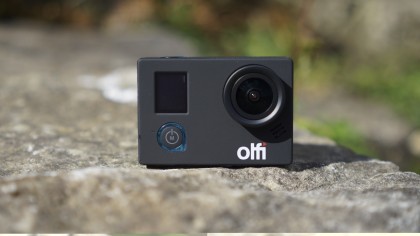Why you can trust TechRadar
Video quality is good throughout the Olfi's various resolutions and frame rates. The 4K footage shows plenty of detail and good colour, tone and contrast. At 4K, 24fps is just enough to capture smooth motion in relatively static scenes, such as groups of people.
The 4K video produced by the camera actually has a resolution of 2880 x 2160, rather than full 4K at 3840 x 2160. This is fairly common practice, and when it's played back most media players will be 'tricked' into showing the footage at full 4K resolution; the footage doesn't seem to suffer for this.

Switching to 1080HD at 30fps the footage again looks good, with even sharpness across the frame and well balanced tone and contrast. Switch to 60fps and you'll see a slight drop in quality, but if you're filming action the captured motion is smooth, and can be nicely slowed to half speed.
Drop the resolution to 720p and you have access to 120fps, enabling footage to be slowed further to quarter speed. Again there's some drop in quality, but the footage is still smooth and clean footage, and produces great-looking slow-motion clips.
Where all action cameras fall down to some extent is low-light performance, and while the Olfi copes better than most, especially when its HDR mode is employed, noise and loss of detail become issues in falling light.
That HDR mode is a stand-out feature, boosting the level of highlight and shadow detail that's captured, and adding real impact to footage.
Changes in exposure are handled well, with the camera generally adjusting and balancing the light without too much trouble. Riding through woodland, where the light typically changes abruptly and often, the Olfi did sometimes struggle to keep up, but then so would most cameras.

The camera can also struggle in high-contrast conditions – for example, when the ground is in shadow and the sky is bright, sky and cloud detail are prone to burning out.
The small lens captures a sharp image across the frame; zooming footage to 100% and studying the very edges of the frame you will see some signs of chromatic aberration, but it's nothing to worry about.
The 160-degree field of view produces typical action camera fisheye distortion, which is pronounced, but there is an option to correct this in-camera if you really feel the need.
We've seen image stabilisation in quite a few cameras, notably the Sony X1000V and Garmin Virb XE, and in both cases the technology works extremely well. In the Olfi there's a similar gyro system, and this is also very effective, helping to smooth out the smaller bumps and vibrations.
Attaching the Olfi to a 3DR SOLO Drone revealed just how well this technology works, with image stability improved dramatically, and it was a similar story when the camera was fitted to a bike.
Viewed side by side with comparable footage from the GoPro Hero4, video quality from the Olfi is good at all resolution and frame rate combos; the GoPro does have the edge when it comes to capturing detail and tonal range, but then it is more than twice the price.
The GoPro's variety of video options also make it the better choice for experienced videographers who want to grade footage post-capture. However, most people looking to create high-quality footage of their adventures will be perfectly happy with the Olfi's results straight from the camera.
Ali Jennings is the imaging lab manager for Future Publishing's Photography portfolio. Using Imatest Master and DxO Analyser he produces the image quality tests for all new cameras and lenses review in TechRadar's cameras channel. Ali has been shooting digital since the early nineties and joined Future's Photography portfolio back in 2003.
